阿里云-性能测试服务用户手册
- 格式:pdf
- 大小:3.70 MB
- 文档页数:47
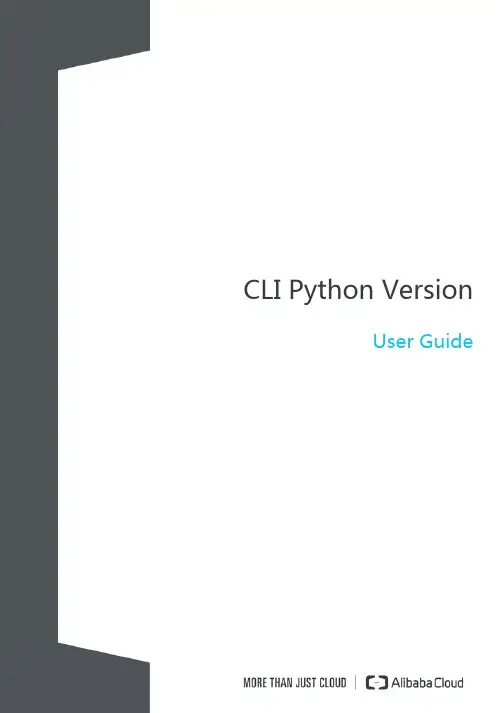
CLI Python VersionUser GuideUser GuideAlibaba Cloud Python SDKsSee the Python SDKs of different Alibaba Cloud products and the commands for installing the SDKs in SDK document Python SDK.Scripts usage samplesUse Shell scriptAlibaba Cloud CLI is a tool for the unified management and configuration of Alibaba Cloud resources. After you install and configure Alibaba Cloud CLI, you can use it to manage multiple Alibaba Cloud products and services simultaneously.To facilitate your use of Alibaba Cloud CLI, we have compiled a script integrating common operations. This document shows how to run the sample Shell script in the Linux operating system.Install and configure Alibaba Cloud CLI.For more information about the installation and configuration procedures, see AlibabaCloud CLI installation guide (Linux/UNIX/Mac OS) and Configuration of Alibaba Cloud CLI.Click here to download the script.Run the following command to extract the downloaded script package.tar zxvf ecs.tar.gzsh ecs.shSelect the operation that you want to perform:The following figure shows the operations that you can select in the first directory:The following figure shows the operations that you can select in the seconddirectory:Query information of the subscribed image market imagesYou can run the following script in Alibaba Cloud CLI to query information (image IDs and names) of all subscribed image market images. You can download or edit the script.Click to download the script: querySubscribedImageId.zipThe script is as follows:`#!/bin/bashtcount=`aliyuncli ecs DescribeImages --ImageOwnerAlias marketplace --output json --filter TotalCount`pageNum=1cat /dev/null >/tmp/imageids.txtwhile ((tcount>0))doaliyuncli ecs DescribeImages --ImageOwnerAlias marketplace --filter Images.Image[*].ImageId --PageSize 100 --PageNumber $pageNum --output json --filter Images.Image[*].ImageId | sed '1d' | sed '$d' | sed 's/,//g' | sed's/"//g'| sed 's/ //g'>>/tmp/imageids.txtlet pageNum++let tcount-=100donecat /tmp/imageids.txt | while read linedoisSubscribed=`aliyuncli ecs DescribeImages --ImageOwnerAlias marketplace --ImageId $line --filterImageIds.Image[*] --filter Images.Image[*].IsSubscribed --output json | sed '1d' | sed '$d' | sed 's/ //g'`if [[ $isSubscribed = "true" ]];thenecho $line `aliyuncli ecs DescribeImages --ImageOwnerAlias marketplace --ImageId $line --filter ImageIds.Image[*] --filter Images.Image[*].ImageName --output json | sed '1d' | sed '$d' | sed 's/ //g'` >>imagesInfo.txtfidonenative2ascii -encoding UTF-8 -reverse imagesInfo.txt imagesInfoCN.txtrm -rf imagesInfo.txtcat imagesInfoCN.txt`After editing or downloading the script and granting the permission (by running the chmod + x command), you can run the script in the following format to generate an imagesInfoCN.txt file containing information of subscribed image market images in the directory storing the script.Example:./querySubscribedImageId.shSample output:# ./querySubscribedImageId.shm-23917oqoi "ASP/.NET runtime environment (Windows 2008 64-bit|IIS7.0) V1.0"m-23n2589vc "Java runtime environment (Centos 64-bit|OpenJDK1.7) V1.0"m-23u9mjjtk "PW website construction system (Centos 64-bit) V1.0"Query all instance IDs in a specified region and export them to a fileYou can run the script below in Alibaba Cloud CLI to query all instance IDs in a specified region, and export them to a file. You can choose to download or edit the script.Click to download the script: getVmList.zipThe script is as follows.#!/bin/bashtcount=`aliyuncli ecs DescribeInstances --RegionId $1 --output json --filter TotalCount`pageNum=1cat /dev/null >vmList.txtwhile ((tcount>0))doaliyuncli ecs DescribeInstances --RegionId $1 --PageSize 100 --PageNumber $pageNum --output json --filter Instances.Instance[*].InstanceId | sed '1d' | sed '$d' | sed 's/,//g' | sed 's/"//g'| sed 's/ //g'>>vmList.txtlet pageNum++let tcount-=100donecat vmList.txtAfter you edit or download the script and grant the permission (by running the chmod + x command), you can run the script in the following format to generate a vmList.txt file containing required instance IDs in the directory storing the script.Format:./getVmList.sh <Region ID>Note: You can obtain the Region ID through the DescribeRegions interface.Example:./getVmList.sh cn-hangzhouSample output:#./getVmList.sh cn-hangzhoucn-hangzhou sg-227f611sscn-hangzhou sg-22esa2s7sQuery the VPC instance ID list with no VSwitch created in all regionsYou can run the following script in Alibaba Cloud CLI to query the VPC instance ID list with no VSwitch created in all regions. You can download or edit the script.Click to download the script: getNoVSWitchVpcIds.zip.The script is as follows:#!/bin/bashfor RegionId in `aliyuncli ecs DescribeRegions --filter Regions.Region[*].RegionId --output json | sed '1d' | sed '$d' | sed 's/,//g' | sed 's/"//g'| sed 's/ //g'`docat /dev/null >/tmp/vpcIDs.txtpageNum=1tcount=`aliyuncli ecs DescribeVpcs --RegionId $RegionId --output json --filter TotalCount`while ((tcount>0))doaliyuncli ecs DescribeVpcs --RegionId $RegionId --filter Vpcs.Vpc[*].VpcId --PageSize 50 --PageNumber $pageNum --output json | sed '1d' | sed '$d' | sed 's/,//g' | sed 's/"//g'| sed 's/ //g'>>/tmp/vpcIDs.txtlet pageNum++let tcount-=50donecat /tmp/vpcIDs.txt | while read linedovSwitchCount=`aliyuncli ecs DescribeVSwitches --VpcId $line --output json --filter TotalCount`if [[ $vSwitchCount -eq 0 ]];thenecho $RegionId $linefidonedoneAfter editing or downloading the script and granting the permission (by running the chmod + x command), you can run the script in the following format to export the VPC instance IDs (in pairs) with no VSwitch created in all regions in the Region ID VpcId format by region.Format:./getNoVSWitchVpcIds.shSample output:[root@AliyunTest]# ./getNoVSWitchVpcIds.shcn-hangzhou vpc-23vyarrssQuery IDs of security groups not associated with any instances in all regionsYou can run the following script in Alibaba Cloud CLI to query security groups not associated withany instances in all regions and perform operations (such as DELETE) on the security groups. You can download or edit the script.Click to download the script: getUnUsedSecurityGroupId.zip.The script is as follows:#!/bin/bashfor RegionId in `aliyuncli ecs DescribeRegions --filter Regions.Region[*].RegionId --output json | sed '1d' | sed '$d' | sed 's/,//g' | sed 's/"//g'| sed 's/ //g'`docat /dev/null >/tmp/UnUsedSecurityGroupIds.txtpageNum=1tcount=`aliyuncli ecs DescribeSecurityGroups --RegionId $RegionId --output json --filter TotalCount`while ((tcount>0))doaliyuncli ecs DescribeSecurityGroups --RegionId $RegionId --filter SecurityGroups.SecurityGroup[*].SecurityGroupId --PageSize 100 --PageNumber $pageNum --output json | sed '1d' | sed '$d' | sed 's/,//g' | sed 's/"//g'| sed 's///g'>>/tmp/UnUsedSecurityGroupIds.txtlet pageNum++let tcount-=100donecat /tmp/UnUsedSecurityGroupIds.txt | while read linedousedVMCount=`aliyuncli ecs DescribeInstances --RegionId $RegionId --SecurityGroupId $line --output json --filter TotalCount`if [[ $usedVMCount -eq 0 ]];thenecho $RegionId " " $linefidonedoneAfter editing or downloading the script and granting the permission (by running the chmod + x command), you can run the script in the following format to export IDs of security groups (in pairs) not associated with any instances in all regions by region and security group.Format:./getUnUsedSGInfo.shSample output:[root@AliyunTest]# ./getUnUsedSGInfo.shcn-qingdao sg-227f61ltscn-shenzhen sg-22esa0f7sStructure and parameters of the command lineOnline help commandFor ease of use, Alibaba Cloud CLI provides online help commands. You can use the help commands to query valid operations supported by Alibaba Cloud products.For instance, if you want to query all the operations supported by ECS, run aliyuncli ecs help command and the query result is shown as follows.If you want to query the parameters of an ECS operation, run aliyuncli ecs <operation name> help. Taking the DescribeRegions operation as an example, the query result is shown as follows.Alibaba Cloud CLI command structureThe Alibaba Cloud CLI command structure is as follows.aliyuncli <command> <subcommand> [options and parameters]aliyuncli: Alibaba Coud CLI, the tool name of Alibaba Cloud.command: a top-layer command which represents an Alibaba Cloud basic service supported by Alibaba Cloud CLI (such as ECS/RDS/SLB/OSS), or a command of Alibaba Cloud CLI (such as “help” and “configure”).subcommand: a subcommand that specifies an operation to be executed, that is, a specificoperation.options and parameters: the parameter list corresponding to the operation specified insubcommand. The ordering of the parameters has no impact on the use of commands.Various types of input values can be used, such as numbers, strings, lists, mappings, andJSON structures.Examples:aliyuncli rds DescribeDBInstances --PageSize 50aliyuncli ecs DescribeRegionsaliyuncli rds DescribeDBInstanceAttribute --DBInstanceId xxxxxxParameter value input requirementsWhen you are calling Alibaba Cloud CLI, you must input the required values according to the following instructions to avoid errors.In most cases, you are required to input a string or numeric value to Alibaba Cloud CLI.Example:$ aliyuncli ecs DescribeInstanceAttribute --InstanceId myInstanceIdIf your inputs contain spaces, use single quotation mark (‘) to include the value. This manner is applicable to Windows PowerShell, Mac OS, and Linux.Example:$ aliyuncli ecs DescribeInstanceAttribute --InstanceId 'my instance id'For Windows Command Processer, use double quotation marks (“) to include the value.Example:> aliyuncli ecs DescribeInstanceAttribute --InstanceId "my instance id"Use JSON format to input parameters. JSON format is allowed in Alibaba Cloud CLI. Especially, when you query information of multiple instances or multiple disks, you can input multiple ID values in JsonArray format. It requires that you strictly edit data in JSON format and perform special processing on double quotation marks (“) in JSON format.To query information of multiple instances, you can input values with double quotation marks (“), like [“my-intances-id1”, “my-instances-id2”]. However, in Python, the double quotation marks (“) are filtered out by default, so special processing is required.On Linux and Mac OS systems, use single quotation mark (‘) to include the entireJSON value.Example:$ aliyuncli ecs DescribeInstances --InstanceIds '["my-intances-id1", "my-instances-id2"]'In Windows Command Processer, use a backslash ( \ ) to represent the doublequotation mark (“), and use double quotation marks (“) to include the entireJSON value.Example:> aliyuncli ecs DescribeInstances --InstanceIds "[\"my-intances-id1\", \"my-instances-id2\"]"In Windows PowerShell, use a backslash ( \ ) to represent the double quotationmark (“), and then use single quotation mark (‘) to include the entire JSON value.Example:> aliyuncli ecs DescribeInstances --InstanceIds '[\"my-intances-id1\", \"my-instances-id2\"]' Command output formatOutput formatTo meet different output format requirements of different users, Alibaba Cloud CLI supports three output formats.JSON (json)JSON format is the default output format of Alibaba Cloud CLI. Most languages have theinternal function or open JSON parser library to parse JSON strings easily. JSON format ismainly used with other scripts or any programming language to facilitate developers’parsing and use. An example is shown as follows.Text separated by Tab (text)In text format, outputs of Alibaba Cloud CLI are arranged into lines separated by Tab. This format is appropriate for traditional UNIX text tools (such as sed, grep, and awk) and Windows PowerShell. The text output format complies with the basic structure shown in the following example. The columns are sorted alphabetically by key names of bottom-layerJSON objects.In table format, data is arranged in an easy-to-read manner. An example is shown as follows.Set the output formatThe output format can be specified in two ways.Method 1: Modify the config file.Use the output option in the config file. The following example shows how to set the output formatto text.Method 2: Use command line.Use the output option in Alibaba Cloud CLI. The following example shows how to set the output format to table.Global parameter descriptionWhen you are using Alibaba Cloud CLI, you can set temporary settings for global parameters. You canadjust the parameters as needed. Currently, the supported global parameters are as follows:AccessKeyId: Specifies the AccessKeyId in the API request for executing the currentcommand. If no value is specified or the value is null, the default global AccessKeyId is[default] output=text $ aliyuncli ecs DescribeInstanceAttribute --InstanceId i-23rjh06vf --output tableapplied.AccessKeySecret: Specifies the AccessKeySecret in the API request for executing the current command. If no value is specified or the value is null, the default global AccessKeySecret isapplied.RegionId: Specifies the region corresponding to the API request for executing the currentcommand. If no value is specified, the global RegionId is applied.output: Specifies the display format for executing the current command.profile: Specifies the account used for executing the current command. If the specifiedaccount does not exist, the default account is used. In addition, if profile appears togetherwith other global parameters, its priority is lower. For example, if profile appears togetherwith AccessKeyId, AccessKeyId is selected as the AccessKey preferentially.version: Specifies the open API version used for executing the current command. If no value is specified, the latest version installed in the system is used.Note: If the parameter directly follows Alibaba Cloud CLI, the current version of AlibabaCloud CLI is displayed.Multi-account useMulti-account useNotices: This feature is useful for users who need to manage many accoutns and many devices. If you only need to manage an accout, ignore this feature.Alibaba Cloud CLI supports multi-account systems. You can configure multiple access keys and secret values, region and output as needed, to meet your different requirements more flexibly. For the information about how to configure accouts in Alibaba Cloud CLI, refer to Configuration of Alibaba Cloud CLI (for Alibaba Cloud users).Basic command structureThe basic command structure of multi-accout management is shown as follows:aliyuncli configure [set/get/list] --profile profilename --key value --key1 value1configure: Manage configurations.set: Set a configuration value. Optional.get: Display a configuration value. Optional.list: List all values of a profile. Optional.profile: Profile used in the current operation, which is a global parameter. For details, refer to the description of profile in Global parameter description. If this option is not included, adefault account is used.key: Specific key for configuring a profile.Value: Value being configured, which is behind key.Accout typeThere are two kinds of accounts in the config file: [default] account and [profile profilename] account. In Alibaba Cloud CLI, if the option profile is not included, the [default] account is used; if the option profile profilename is included, [profile profilename] is used.The following shows the examples of profile:aliyuncli configure ←Configure [default] account quicklyaliyuncli configure --profile test ←Configure [profile test] account quicklyThe following shows the examples of set:aliyuncli configure set --output table --region cn-qingdao ←Set [default] account, output=table, region=cn-qingdaoaliyuncli configure set --output json --region cn-hangzhou --profile test1 ←Set [profile test1] account, output = json, region = cn-hangzhouThe following shows the examples of get:Output: region = cn-hangzhouOutput:output = jsonregion = cn-hangzhouThe following shows the examples of list:The output is as follows:Advanced filter functionNote : This feature is used for users who have many instances. If you have only one instance, ignorethis feature.Data returned upon Alibaba Cloud API calls can be presented in different formats, but it is alsocomplex. Alibaba Cloud CLI further provides the data filter function, allowing you to filter data usingfilters. The filter function can help you obtain the expected value from the result, and can be used tohandle results easily and quickly in use or secondary development.Data returned upon API calls is in JSON format by default. Therefore, when using Alibaba Cloud CLI,aliyuncli configure get region ←Get the region of [default] accountaliyuncli configure get output region ←Get the output and region values of [default] accountaliyuncli configure get region --profile profile1 ←Get the region under [profile profile1] accountaliyuncli configure list ←List information under [default] accountaliyuncli configure list --profile profile1 ←List information under [profile profile1] accountyou can use the filter function according to JSON characteristics to obtain your expected results.Taking ECS DecribeRegions for example, run the following command, and the original JSON format output is shown as follows.aliyuncli ecs DescribeRegions --output jsonFilter 1You can enter a key value for filtering. Run the following command, and the filter output is shown as follows.aliyuncli ecs DescribeRegions –output json –filter RegionsFilter 2If the JSON value is an array, the array subscript format is supported. Run the following command,and the filter output is shown as follows.Especially, Alibaba Cloud CLI also supports ‘*’, representing the set of all results. Multiple filterresults are returned as an array. Run the following command, and the filter output is shown as follows.Filter 3 Filter one value from the returned data. Run the following command, and the filter output is shown asaliyuncli ecs DescribeRegions –output json –filter Regions.Region[0]aliyuncli ecs DescribeRegions –output json –filter Regions.Region[*].RegionIdfollows.aliyuncli ecs DescribeRegions –output json –filter Regions.Region[3].RegionId。

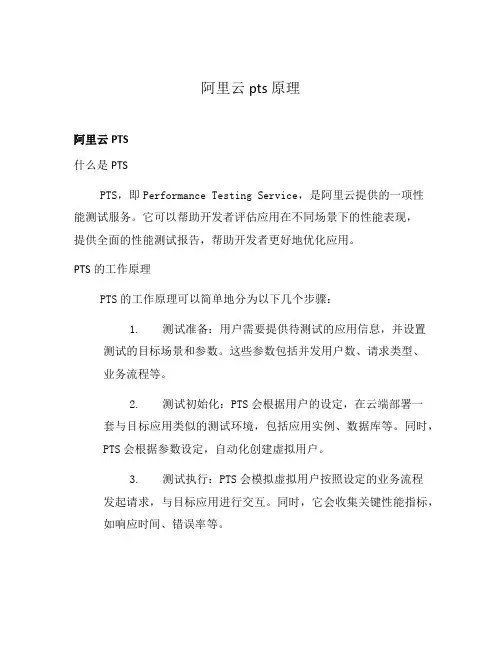
阿里云pts 原理阿里云PTS什么是PTSPTS,即Performance Testing Service,是阿里云提供的一项性能测试服务。
它可以帮助开发者评估应用在不同场景下的性能表现,提供全面的性能测试报告,帮助开发者更好地优化应用。
PTS的工作原理PTS的工作原理可以简单地分为以下几个步骤:1.测试准备:用户需要提供待测试的应用信息,并设置测试的目标场景和参数。
这些参数包括并发用户数、请求类型、业务流程等。
2.测试初始化:PTS会根据用户的设定,在云端部署一套与目标应用类似的测试环境,包括应用实例、数据库等。
同时,PTS会根据参数设定,自动化创建虚拟用户。
3.测试执行:PTS会模拟虚拟用户按照设定的业务流程发起请求,与目标应用进行交互。
同时,它会收集关键性能指标,如响应时间、错误率等。
4.测试分析:PTS会将收集到的性能指标进行分析,生成详细的测试报告。
报告中包括各项指标的数据统计和图表展示,以及对性能瓶颈的识别和优化建议。
PTS的优势PTS相对于传统的性能测试方式,具有以下几个优势:•弹性扩展:PTS可以随时根据用户的需求,扩展测试规模。
无论是并发用户数增加,还是增加测试环境的规模,PTS都能迅速应对。
•实时监控:PTS提供实时监控功能,用户可以实时查看测试过程中各项指标的数据。
这让用户能够快速检测性能问题,并及时采取优化措施。
•全面分析:PTS提供全面的性能分析报告,从各个维度展示应用的性能状况。
这使得用户能够全面了解应用的性能瓶颈,有针对性地进行调优。
•节约成本:传统的性能测试往往需要大量的人力和物力投入,而PTS可以节约这部分成本。
用户只需支付PTS的使用费用,就能获得全面的性能测试服务。
使用PTS的步骤使用PTS进行性能测试可分为以下几个步骤:1.准备应用信息:用户需提供目标应用的基本信息,包括应用类型、应用规模、业务场景等。
2.设置测试参数:用户需要设置测试的参数,如并发用户数、请求类型、业务流程等。
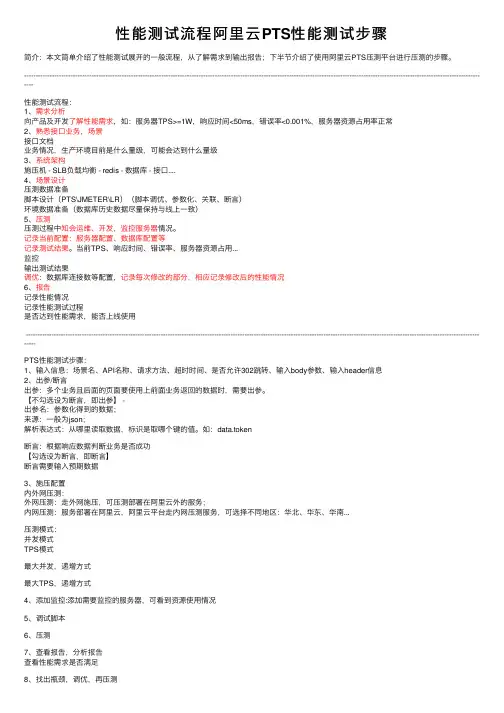
性能测试流程阿⾥云PTS性能测试步骤简介:本⽂简单介绍了性能测试展开的⼀般流程,从了解需求到输出报告;下半节介绍了使⽤阿⾥云PTS压测平台进⾏压测的步骤。
--------------------------------------------------------------------------------------------------------------------------------------------------------------------------------------------------------性能测试流程:1、需求分析向产品及开发了解性能需求,如:服务器TPS>=1W,响应时间<50ms,错误率<0.001%,服务器资源占⽤率正常2、熟悉接⼝业务,场景接⼝⽂档业务情况,⽣产环境⽬前是什么量级,可能会达到什么量级3、系统架构施压机 - SLB负载均衡 - redis - 数据库 - 接⼝....4、场景设计压测数据准备脚本设计(PTS\JMETER\LR)(脚本调优、参数化、关联、断⾔)环境数据准备(数据库历史数据尽量保持与线上⼀致)5、压测压测过程中知会运维、开发,监控服务器情况。
记录当前配置:服务器配置、数据库配置等记录测试结果。
当前TPS、响应时间、错误率、服务器资源占⽤...监控输出测试结果调优:数据库连接数等配置,记录每次修改的部分,相应记录修改后的性能情况6、报告记录性能情况记录性能测试过程是否达到性能需求,能否上线使⽤--------------------------------------------------------------------------------------------------------------------------------------------------------------------------------------------------------PTS性能测试步骤:1、输⼊信息:场景名、API名称、请求⽅法、超时时间、是否允许302跳转、输⼊body参数、输⼊header信息2、出参/断⾔出参:多个业务且后⾯的页⾯要使⽤上前⾯业务返回的数据时,需要出参。

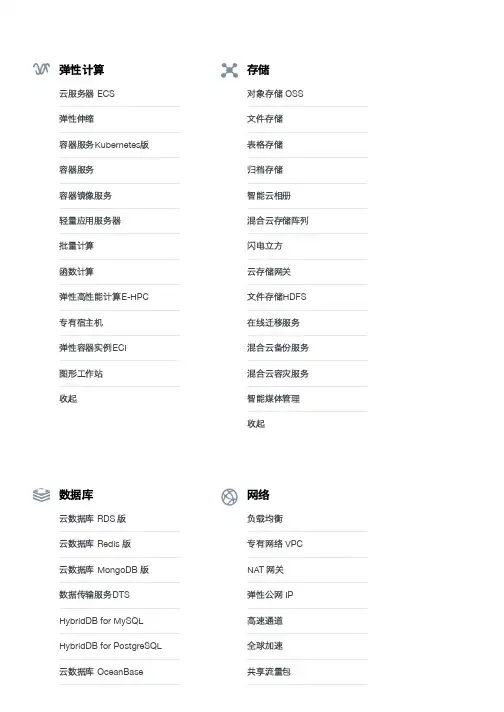


产品使用手册路由器接口通过控制台可以对路由器接口进行查看、创建、添加对端接口、发起连接、修改信息、冻结、激活、删除等操作。
创建路由器接口路由器接口列表页面,点击右上角按钮"创建路由器接口",进入路由器接口售卖页。
在路由器接口售卖页,选择路由器接口的本端配置、对端配置和角色规格,进行创建。
添加对端路由器接口在列表中点击添加,可以为当前路由器接口添加对端信息。
如果需要配对的为同账号下的路由器接口,直接在下拉框中选择目标路由器接口即可,并且此处已通过地域、路由器类型以及状态为您初步筛选可配对的路由器接口。
勾选"将当前路由器接口配置为所选路由器接口的对端"后,会自动将选中的路由器接口的对端信息配置为当前路由器接口。
如果需要配对的为其他账号下的路由器接口,需要在所属账号中选择其他账号,并填写目标路由器接口的账号ID、路由器ID以及路由器接口ID。
如果需要修改对端接口信息,可以重新添加对端接口信息,也可以通过"更多"中"编辑对端接口信息"进行修改。
编辑本端接口信息在"更多"中,选择"编辑本端接口信息"可以修改路由器接口的名称和描述。
发起连接添加好对端接口信息且角色为发起端的接口,可以发起两个路由器接口之间的连接。
发起连接成功后,作为发起端的路由器接口将开始计费。
配置路由可以通过"配置路由"功能跳转到接口所属的路由器界面,配置自定义路由。
添加自定义路由时,选择下一跳类型为"路由器接口"冻结路由器接口处于"已激活"状态的路由器接口可以将其冻结,冻结后路由器接口将不会再有数据通过。
激活路由器接口处于"已冻结"状态的路由器接口可以将其激活,激活后数据将正常通过路由器接口发送。
删除路由器接口通过"更多"中的"删除",可以将处于"未连接"或"已冻结"状态的路由器接口删除。

阿里云免费使用及手册——(免费卷领取技巧)一、阿里云简介 (3)二、阿里云优势 (5)超大规模数据中心遍布全球 (5)5大优势,助客户从0搭建到秒级部署云环境 (5)极具竞争力的产品体系 (5)强劲的发展速度 (6)2016年第三季度,阿里云付费用户数量增长至 65.1 万,推动收入同比增长 130%,达到 14.93 亿元的历史新高。
云计算付费用户数量同比增长 108%,覆盖金融、医疗、公共交通、能源、制造、政府机构、游戏、多媒体等行业和企业类型。
在全球云计算行业,阿里云的增速已大幅领先。
(6)三、阿里云优惠及免费(建立在实名认证的基础上) (7)四、阿里云产品 (8)1、弹性计算 (8)2、存储和CDN (8)3、数据库 (8)4、移动云 (9)5、安全 (9)五、阿里云大事记 (10)一、阿里云简介阿里云LOGO:阿里云()创立于2009年,是全球领先的云计算及人工智能科技公司,为200多个国家和地区的企业、开发者和政府机构提供服务。
根据 Gartner 最新市场份额研究数据[1]显示,阿里云已成为全球前三大公共云服务提供商。
2017年1月阿里云成为奥运会全球指定云服务商。
截至2017年3月,阿里云付费云计算用户达87.4万。
阿里云致力于以在线公共服务的方式,提供安全、可靠的计算和数据处理能力,让计算和人工智能成为普惠科技。
阿里云在全球各地部署高效节能的绿色数据中心,利用清洁计算为万物互联的新世界提供源源不断的能源动力,目前已经在全球15个地域设立有数十个飞天数据中心,均部署阿里云自研的飞天操作系统,并提供中、英、日三种语言支持。
阿里云ET拥有全球领先的人工智能技术,目前已具备智能语音交互、图像/视频识别、交通预测、情感分析等技能。
ET的优势在于对全局的洞察和实时决策上,在复杂局面下快速做出最优决定。
目前,ET开始在城市治理、交通调度、工业制造、健康医疗、司法等领域成为人类的强大助手。
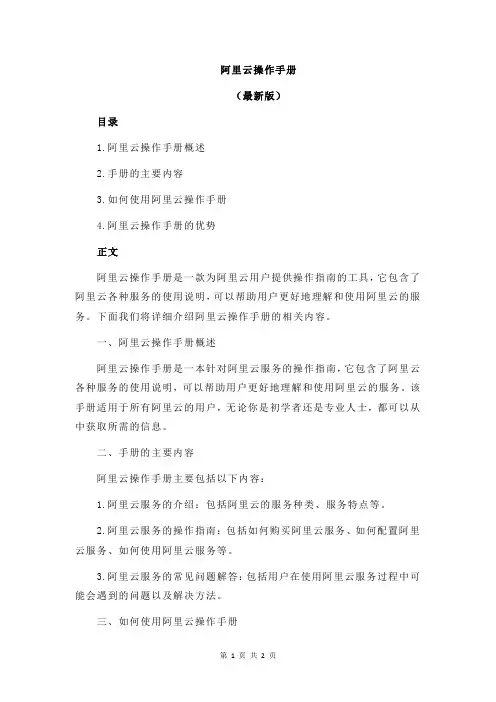
阿里云操作手册(最新版)目录1.阿里云操作手册概述2.手册的主要内容3.如何使用阿里云操作手册4.阿里云操作手册的优势正文阿里云操作手册是一款为阿里云用户提供操作指南的工具,它包含了阿里云各种服务的使用说明,可以帮助用户更好地理解和使用阿里云的服务。
下面我们将详细介绍阿里云操作手册的相关内容。
一、阿里云操作手册概述阿里云操作手册是一本针对阿里云服务的操作指南,它包含了阿里云各种服务的使用说明,可以帮助用户更好地理解和使用阿里云的服务。
该手册适用于所有阿里云的用户,无论你是初学者还是专业人士,都可以从中获取所需的信息。
二、手册的主要内容阿里云操作手册主要包括以下内容:1.阿里云服务的介绍:包括阿里云的服务种类、服务特点等。
2.阿里云服务的操作指南:包括如何购买阿里云服务、如何配置阿里云服务、如何使用阿里云服务等。
3.阿里云服务的常见问题解答:包括用户在使用阿里云服务过程中可能会遇到的问题以及解决方法。
三、如何使用阿里云操作手册要使用阿里云操作手册,用户可以按照以下步骤进行:1.登录阿里云官网,进入控制台。
2.在控制台页面,选择“帮助中心”。
3.在帮助中心页面,选择“操作手册”。
4.在操作手册页面,可以根据需要选择相应的服务进行查看。
四、阿里云操作手册的优势阿里云操作手册具有以下优势:1.详细的操作说明:阿里云操作手册包含了各种服务的详细操作说明,可以帮助用户更好地理解和使用阿里云的服务。
2.实时更新:阿里云操作手册会根据阿里云服务的更新情况进行实时更新,保证用户获取到的信息是最新的。
3.多样化的学习方式:阿里云操作手册支持在线查看和下载 PDF 两种方式,用户可以根据自己的需要进行选择。
总的来说,阿里云操作手册是一款非常实用的工具,它可以帮助用户更好地理解和使用阿里云的服务,提高用户的工作效率。

云服务器使用手册for linux1、远程连接服务器 (1)2、Linux 系统挂载数据盘 (2)3、Linux FTP服务配置 (5)4、如何添加网站for linux(绑定域名) (6)5、linux一键安装web环境全攻略 (7)阿里云链接地址:/manual?spm=0.0.0.0.KpixOR&lastSortId=234一、远程连接Linux云服务器-命令行模式1、远程连接工具。
目前Linux远程连接工具有很多种,您可以选择顺手的工具使用。
下面使用的是名为Putty的Linux远程连接工具。
该工具是免费的,且不需要安装,在网上方便地下载到。
2、启动Putty.exe程序,进入Putty主界面。
在Putty “Host Name”输入IP地址,在Sav ed Session中输入希望保存的名字(可以任意),点击“Save”;以后可以方便调用而不需要每次输入IP地址;点击“Open”进行连接。
3、初次运行时,会有下图中的提示,请选择“是(Y)”,下次运行就不会再出现该提示信息了。
4、请根据提示,分别输入您的Linux云服务器用户名和密码。
密码不会显示在屏幕上。
输入完成后回车即可。
二、Linux 系统挂载数据盘适用系统:Linux(Redhat , CentOS,Debian,Ubuntu)* Linux的云服务器数据盘未做分区和格式化,可以根据以下步骤进行分区以及格式化操作。
下面的操作将会把数据盘划分为一个分区来使用。
1、查看数据盘在没有分区和格式化数据盘之前,使用“df –h”命令,是无法看到数据盘的,可以使用“fdisk -l”命令查看。
如下图:友情提示:若您执行fdisk -l命令,发现没有/dev/xvdb 标明您的云服务无数据盘,那么您无需进行挂载,此时该教程对您不适用2、对数据盘进行分区执行“fdisk /dev/xvdb”命令,对数据盘进行分区;根据提示,依次输入“n”,“p”“1”,两次回车,“wq”,分区就开始了,很快就会完成。
阿里云操作手册
摘要:
1.阿里云操作手册概述
2.手册的内容
3.使用阿里云的建议
正文:
阿里云操作手册概述
阿里云操作手册是一本详细的指南,它为使用阿里云服务的用户提供了全面的操作指导。
该手册包含了各种实用的技巧和方法,可以帮助用户更轻松、更高效地使用阿里云。
无论是初学者还是有经验的用户,都可以从这本手册中获益。
手册的内容
阿里云操作手册主要包括以下几个方面的内容:
1.阿里云服务的介绍:包括阿里云的使命、愿景、核心价值观,以及阿里云服务的特点和优势。
2.阿里云服务的使用方法:包括如何注册阿里云账号、如何购买阿里云服务、如何使用阿里云控制台和管理台等。
3.阿里云服务的操作技巧:包括如何创建和管理云服务器、如何使用和配置云数据库、如何设置和监控云网络等。
4.阿里云服务的安全保障:包括如何设置安全组和防火墙、如何进行数据备份和恢复、如何保障云服务器的安全等。
使用阿里云的建议
使用阿里云服务,可以参考以下建议:
1.了解阿里云服务的特点和优势:这样可以更好地选择和使用阿里云服务,提高工作效率和质量。
2.熟悉阿里云操作手册:这样可以更轻松、更高效地使用阿里云服务,避免一些不必要的错误和问题。
3.注重安全保障:使用阿里云服务时,要注重安全保障,避免因为安全问题而导致数据丢失或者服务中断。
4.定期进行数据备份和恢复:这样可以更好地保障数据的安全,避免因为数据丢失而导致的工作中断或者数据丢失。
阿里云操作手册是一本实用的指南,可以帮助用户更好地使用阿里云服务。
无论是初学者还是有经验的用户,都可以从这本手册中获益。
阿里云服务器使用教程阿里云服务器使用教程阿里云服务器是一种云计算产品,可以提供稳定可靠的云计算服务。
它具有灵活性强、安全性高、成本低等特点,是个人和企业在互联网上搭建网站、应用程序等的首选。
以下是阿里云服务器的使用教程:第一步:购买阿里云服务器1. 打开阿里云官网,登录账号。
2. 进入产品界面,选择云服务器ECS。
3. 选择适合自己需求的服务器配置,并添加到购物车。
4. 确认订单并进行支付。
第二步:配置阿里云服务器1. 在购买成功后,进入控制台。
2. 在实例列表中,选择已购买的服务器实例。
3. 点击“管理”按钮,进入服务器管理页面。
4. 在服务器管理页面中,可以进行网络设置、安全设置、存储设置等。
5. 根据实际需求配置服务器参数。
第三步:登录阿里云服务器1. 在实例列表中,找到已购买的服务器实例。
2. 在服务器实例详情页中,找到公网IP地址。
3. 使用SSH工具(如PuTTY)连接服务器:在工具中输入公网IP地址、用户名和密码,点击连接。
4. 成功连接后,即可通过终端进行服务器的操作和管理。
第四步:部署网站或应用程序1. 通过SSH连接服务器后,可以使用命令行工具进行相关操作,如安装软件、配置环境等。
2. 将网站或应用程序的文件上传至服务器。
3. 配置域名解析,将域名指向服务器的公网IP地址。
4. 安装Web服务器软件(如Nginx、Apache)。
5. 配置Web服务器,将域名与网站或应用程序进行绑定。
6. 测试访问网站或应用程序,确保正常运行。
第五步:监控和维护1. 阿里云服务器提供了监控服务,可以查看服务器的运行状态、网络流量等。
2. 根据实际需求设置告警规则,及时获得服务器异常情况的通知。
3. 定期对服务器进行维护,如更新操作系统、软件补丁等。
4. 配置定期备份,以防数据丢失。
总结:以上就是阿里云服务器的基本使用教程。
购买、配置、登录和部署是使用阿里云服务器的关键步骤。
在使用过程中,可以根据需要进行进一步的设置和优化,以提高服务器的性能和安全性。
阿里云使用说明1、安装VC(即运行vcredist_x86.rar文件)大家可以通过卸载或更改程序查看自己是否装了,我这里装了很多个,就不用再装了。
没准过的直接点击vcredist_x86.exe安装就行。
2、安装 NvMultiDown1。
1)先将NvMultiDown1.rar解压出来。
接着打开文件夹,进入到usbpcdriver这一层,将这一层的地址复制下来,等下有用。
因为我解压在桌面W700这个文件夹里面,因此我的地址是C:\Users\John\Desktop\W700\NvMultiDown1.0.1.4\usbpcdriver。
2)安装驱动。
给W700插入USB线,关机。
然后按“上音量键”+“开机键”,显示绿屏后松手(进入AP模式),松手后黑屏。
然后插入USB线,此时PC端会弹出安装驱动界面,如图一所示:选择更新驱动软件程序软件选择浏览计算机以查找驱动程序软件粘贴之前复制的地址选始终安装驱动安装成功后在“设备管理器”里的“通用串行总线控制器”节点下会有“NVDIA USBBoot-recovery driver for Mobile devices”。
3、开始刷机1)解压刷机包到文件夹。
2)运行NvMultiDown1.0.1.4\NvMultiDown目录下的NvMultiDown.exe应用程序3)点击右上角的“…”浏览按钮按钮,找到刷机包所在的文件夹路径,单击确定键4)拆电池 ? 装电池 ? 按“上音量键”+“开机键” ? 显示绿屏后松手进入黑屏 ? 插入USB线。
NvMultiDown的状态提示栏右侧的标识块为深蓝色,便说明开始自动刷机了。
刷机时间大概需要两分钟左右的时间,如果成功,状态标识块变为绿色。
6)最后拆电池,再装上,开机原生Android 2.2来了。
云数据库RDS运维指南··法律声明法律声明阿里云提醒您在阅读或使用本文档之前仔细阅读、充分理解本法律声明各条款的内容。
如果您阅读或使用本文档,您的阅读或使用行为将被视为对本声明全部内容的认可。
1. 您应当通过阿里云网站或阿里云提供的其他授权通道下载、获取本文档,且仅能用于自身的合法合规的业务活动。
本文档的内容视为阿里云的保密信息,您应当严格遵守保密义务;未经阿里云事先书面同意,您不得向任何第三方披露本手册内容或提供给任何第三方使用。
2. 未经阿里云事先书面许可,任何单位、公司或个人不得擅自摘抄、翻译、复制本文档内容的部分或全部,不得以任何方式或途径进行传播和宣传。
3. 由于产品版本升级、调整或其他原因,本文档内容有可能变更。
阿里云保留在没有任何通知或者提示下对本文档的内容进行修改的权利,并在阿里云授权通道中不时发布更新后的用户文档。
您应当实时关注用户文档的版本变更并通过阿里云授权渠道下载、获取最新版的用户文档。
4. 本文档仅作为用户使用阿里云产品及服务的参考性指引,阿里云以产品及服务的“现状”、“有缺陷”和“当前功能”的状态提供本文档。
阿里云在现有技术的基础上尽最大努力提供相应的介绍及操作指引,但阿里云在此明确声明对本文档内容的准确性、完整性、适用性、可靠性等不作任何明示或暗示的保证。
任何单位、公司或个人因为下载、使用或信赖本文档而发生任何差错或经济损失的,阿里云不承担任何法律责任。
在任何情况下,阿里云均不对任何间接性、后果性、惩戒性、偶然性、特殊性或刑罚性的损害,包括用户使用或信赖本文档而遭受的利润损失,承担责任(即使阿里云已被告知该等损失的可能性)。
5. 阿里云网站上所有内容,包括但不限于著作、产品、图片、档案、资讯、资料、网站架构、网站画面的安排、网页设计,均由阿里云和/或其关联公司依法拥有其知识产权,包括但不限于商标权、专利权、著作权、商业秘密等。
非经阿里云和/或其关联公司书面同意,任何人不得擅自使用、修改、复制、公开传播、改变、散布、发行或公开发表阿里云网站、产品程序或内容。